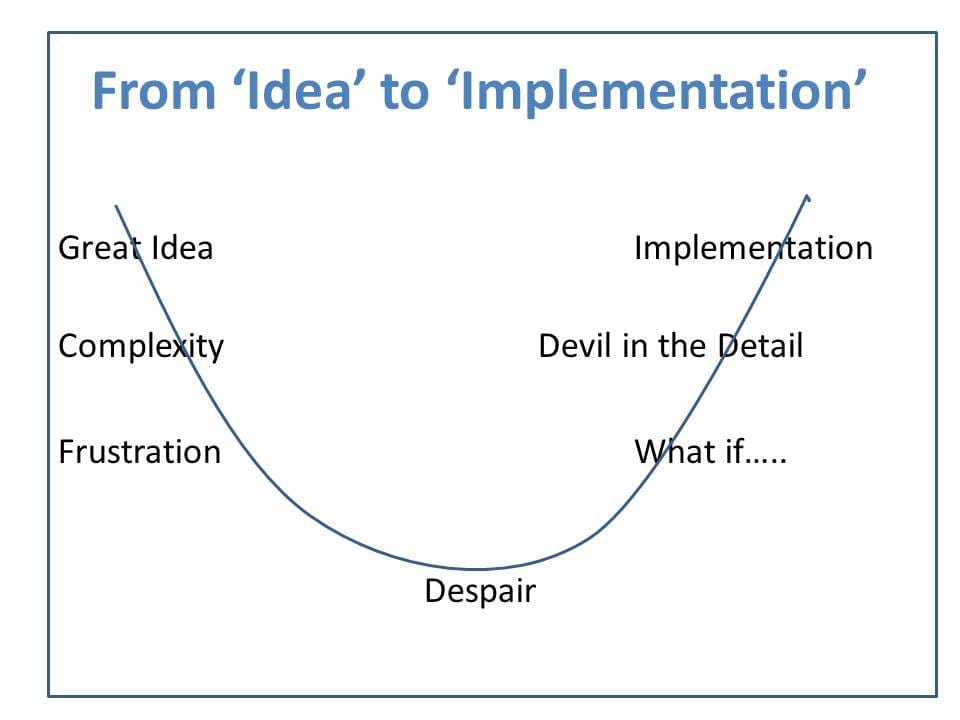
You go through a roller coaster of emotions. Here, we categorise the key stages in a ‘U’ shaped curve. You need to transition these stages if that ‘good idea’ will become a living reality.
Only 3-5% success
And you should know that an idea has only about 3-5% chance of taking hold or working for you and your business unless you deal with these emotional stages of learning and motivation. You should know that you have to go through some fairly negative stages and emotions in order to make any ‘idea’ work and become ‘reality’.
You don’t know what you need to know
Believe me, to go through the process requires more perspiration than inspiration. It requires us to maintain the momentum and learn things that you don’t know yet. The problem is that ‘you don’t know what you don’t know’. I am going to take you through the key 7 stages of this learning model.
Going through each of the stages will enable you to understand the process and maintain your momentum and your motivation to see your ideas through from ‘idea generation’ to implementation and success.
Making the model work in practise
I am going to talk you through the model and at the same time illustrate from my own personal experience how it worked for me – these comments are in italics.
Here’s our view of the stages that you need to work through to make that idea a reality. To illustrate the process I will refer to a huge project which I undertook some three years ago. This was the design and delivery of our on-line Content Learning Management System (CLMS) conforming to ISO 15035 parts 1 & 2, enabling students to complete their Lean Six Sigma Business Transformation Yellow, Green and Black Belt Training on-line, rather than having to attend a series of training workshops.
These are the stages we went through………….you’ll note they follow a ‘U’ shaped curve which dips down into the swamp of despair! The idea is that to make ideas work, you usually have to transition through degrees of frustration, indecision and just plain not knowing what to do. I call this learning.
( Note -The two scales on the diagram are the Vertical axis measuring an increase in 'emotional wellbeing' against the horizontal axis which is Time taken to work through the process).

1. Great Idea
This is where you have a great and unique idea that consumes your thinking. You know it will work – but you don’t know how.
My experience is………….”My personal CLMS project had many benefits if we could pull it off. It will save students the costs of travel, accommodation and time in attending workshops. This is going to be better than I thought, because it means that people signing up to the programs can complete them at their own pace, and free up their time to undertake assignments when they prefer, rather than having to attend training workshops miles from home.”
You can see there are many challenges for any great idea to see it through to working in the real world. You might want to think of how you can make your good idea sing.
2. Complexity
This is where many new projects or initiatives flounder. Think of major ideas that you have had to make live in your own organisation. It requires lots of personal investment in thinking time, bouncing ideas off others and ensuring you fully understand the dynamics of how it could work.
They always are more complex than they appear - but – it is only when you start off working with the idea, sifting and filtering through your own different levels of understanding, that the real complexity and key interdependencies start to emerge.
My experience is…………”This is going to be more difficult than I originally thought. I have to write the content, configure and upload it myself, which means I need to work through HTML code. This is going to be a lot of hard work and require more time and resource. Further, do I have the skill set sufficient to complete the task 100% right?”
3. Frustration
This really is much more complex than when you had the original thought. There is more to it than meets the eye. This is going to take you longer and require more effort and loads of creative thinking. This is where Murphy’s Law operates. “Everything takes longer than you think, and if anything can go wrong it will go wrong”.
You may be unsure of whether you have the capability to drive the project, or you are not sure you know what you are doing and whether it will work. This is where serious doubt sets in.
My experience is………….”The CLMS project was much bigger project than considered initially. The length of the text supporting the CLMS was over 170,000 words, split into 28 chapters…there are diagrams to consider and of course statistical notation…where do I start?”
4. Despair
This is where you enter the swamp of despair. You are at the bottom of the ‘U’ shaped curve and you are not so sure of where to go and what to do. Now, you really are concerned that it may not work.
It will be no surprise that 95% of good ideas are abandoned here or at an even earlier stage. You cannot see the solutions, and things are still a little hazy. If you have to explain the idea to others, you put yourself at risk because it is not clear in your own mind.
You are not sure if this is going to work. You really need to test this and seek the opinions of others, especially your key clients, stakeholders, customers and end users. Will it operate exactly the way you want it to? Will it deliver the desired outcomes? Are you closer to achieving what you want or further away?
Things are going okay but it still is going to be hard but you see it through and you invest your best thinking into the project.
My experience is…………….”We are going to have to be resourceful. It is a mental state of mind. We are going to design and deliver this CLMS to deliver to our Business Transformation students and cohorts….we know it is tough but we can figure it all out if we adopt a different level of thinking and break things down into component parts and use our creative abilities to create a unique approach to learning.”
5. What if……..
Perhaps it would work if you did X…….. This is where all the hard work and effort in the negative emotional stages of your learning turns into a firm commitment to make it work. Your intellectual and emotional efforts are brought into play. Your personal commitment, your motivation for implementing the ‘idea’, product or service comes into being. You have been through a lot to get the idea from where it was through the ‘swamp of despair’, but you can see the light of day and you know good things can happen.
My experience is…………..”There has to be a solution to this….people have designed complex CLMS’s before. I will have to use creative techniques to ensure we don’t focus on orthodox solutions to complex problems. What if we did things differently? What if we used mind mapping in the process and how about 6-3-5 brainstorming. How about getting others involved in the process and run a creative thinking session?”
6. Devil in the Detail
It looks like it could work if you put more effort into it. This means getting into the real detail and ensuring that you close all feedback loops and test your idea and its implementation for robustness and reliability.
My experience is…….” I know there are multiple routes to the same destination – so we are going to process map the perfect process getting us to think through the key stages of the project, the potential barriers and opportunities for improvement, and complete a detailed road-map of possibilities and action tied to deadlines and mini KPI’s. That will work.”
7. Implementation
You never thought you’d get there but you did. Incredible – You were not sure that you would make it, but you did it. You were not sure how things would work out, but you learned on the way. You tested and retested. You tried multiple approaches and learned from others. It was truly worth all the hard work.
My experience is…………”If you think things through, adopt a creative mindset, test for understanding, ask for support, input and advice then you will get the end result. The process of going to solve and implement the idea gives such emotional reward and personal pride in seeing the ideas through to the end.
We developed a great product that is loved by students, companies and organisations because it is a self-sustaining learning process that enables the organisation to successfully manage and accelerate improvement”
Summary
The key skill that got you through from idea to implementation was your mental robustness. You believed in yourself and you committed to make things work. There were times when you did not know what you were doing. There were times when you still had to acquire new skills, you still had to learn, to make the project work.
How do I use this Model?
I use it in all my work. I use it when:
- I write articles for Journals (8 per year)
- Create and produce on-line video learning programs for www.Udemy.com
- Develop creative thinking workshops for Leaders and managers and work teams
- Design RIE’s (Rapid Improvement Events) to solve complex organisational problems
- Create innovative change management experiences for Workshops and Conferences
If you’d like support in using this model perhaps in an organisational or team setting, we can deliver an event to train your people in how best to steer through the difficult stages of any process or project you may have on your agenda.
We will work through and develop your people in:
- New Age Learning & Problem Solving
- Mastering the ’Idea to Implementation’ Curve
- Key personal and group Behaviours to work through the process
- Creative Thinking
- Group processes to support problem solving and nailing implementation
Just phone or email me and we can arrange a discussion. 44(0)7779-799286 or Email
Philip Atkinson
 RSS Feed
RSS Feed

